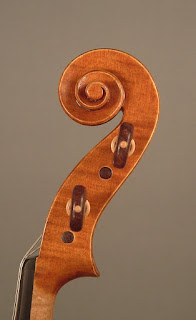I made this instrument in 2010.
The back is made out of a piece of "Oppio" maple, the top plate is from a spruce tree that I have found near my birthplace, in Valle d'Aosta. It has a very pronounced "bear-claw" figure and it's density is about 0.46, so it's heavier than usual.
Varnish is a personal recipe similar to the famous Marciana oil varnish, but I made it with walnut oil instead of linseed.
Notes about my work: making and repairing violins and other bowed musical instruments
Saturday, July 28, 2018
Gennaro Gagliano 1748 cello
This is an instrument I made in 2012.
The pattern is from a cello that was made by Gennaro Gagliano in Naples, dated 1748.
The original instrument is owned by Dextra Musica Foundation in Norway.
The pattern is from a cello that was made by Gennaro Gagliano in Naples, dated 1748.
The original instrument is owned by Dextra Musica Foundation in Norway.
Reinstalling a Full Circle Pickup
My customer saved this bass bridge from another instrument and apparently got its Full Circle pickup/adjusters mixed up at some time. One screw (the active one) is now 1/4"-20 (the one that I recommend) and the other is 6mm metric thread. When it was placed on the other bass, it had a set of brass adjusters and a much lower projection.
I decided to add two shims over the adjusters and to fill the old holes with wooden dowels.
Then I reinstalled the Full Circle in my usual way (threads up) because my customers prefer that the Full Circle be installed with the hot side facing the instrument's top plate. Since one of the threads is metric, and I didn't have a spare 1/4" x20 wheel, I decided to add a small aluminum threaded nut in the bridge leg. Metric thread doesn't hold in wood as well as the inch thread does.
For the 1/4"x20 side, I usually cut the threads, wet them with cyanoacrilate glue and cut again once dried. This is enough to make the threads stronger.
In my area, there are no extremes in humidity, so adjusters aren't strictly necessary, but many players like to have a little choice in string action, especially if they play different styles or if they change between different kinds of strings.
I try to explain, however, that bridge adjusters are not for setting the string action (as it would be in a guitar's Tune-O-Matic) but for compensating for the humidity changes. If one wheel is set much higher than the other, the bridge top will go off-center relative to the fingerboard and this will unbalance the string height again.
I decided to add two shims over the adjusters and to fill the old holes with wooden dowels.
Then I reinstalled the Full Circle in my usual way (threads up) because my customers prefer that the Full Circle be installed with the hot side facing the instrument's top plate. Since one of the threads is metric, and I didn't have a spare 1/4" x20 wheel, I decided to add a small aluminum threaded nut in the bridge leg. Metric thread doesn't hold in wood as well as the inch thread does.
For the 1/4"x20 side, I usually cut the threads, wet them with cyanoacrilate glue and cut again once dried. This is enough to make the threads stronger.
In my area, there are no extremes in humidity, so adjusters aren't strictly necessary, but many players like to have a little choice in string action, especially if they play different styles or if they change between different kinds of strings.
I try to explain, however, that bridge adjusters are not for setting the string action (as it would be in a guitar's Tune-O-Matic) but for compensating for the humidity changes. If one wheel is set much higher than the other, the bridge top will go off-center relative to the fingerboard and this will unbalance the string height again.
Wednesday, July 18, 2018
Setting up my blog - Welcome!
Hi all,
I have decided to collect a bunch of notes and pictures from my violin workshop into a publicly accessible web blog.
I am an Italian violinmaker working in Siracusa, and I have been self-employed from 2003 with just a brief hiatus during the moving from Cremona to Sicily.
My aim is to get feedback from any fellow makers willing to participate in this and also, to present my work and finished instruments to other makers and prospective employers.
I am planning to move to another country and work as an employee, to gain a greater stability and to settle down in a richer social and professional environment. My dream is quite simple after all, getting to have a decent living, by doing the job that I love.
I hope that the materials presented will be of interest to some; comments are welcome!
Giovanni
Note: my Google+ page will be discontinued due to lack of audience on that social media platform.
I have decided to collect a bunch of notes and pictures from my violin workshop into a publicly accessible web blog.
I am an Italian violinmaker working in Siracusa, and I have been self-employed from 2003 with just a brief hiatus during the moving from Cremona to Sicily.
My aim is to get feedback from any fellow makers willing to participate in this and also, to present my work and finished instruments to other makers and prospective employers.
I am planning to move to another country and work as an employee, to gain a greater stability and to settle down in a richer social and professional environment. My dream is quite simple after all, getting to have a decent living, by doing the job that I love.
I hope that the materials presented will be of interest to some; comments are welcome!
Giovanni
Note: my Google+ page will be discontinued due to lack of audience on that social media platform.
Subscribe to:
Comments (Atom)















